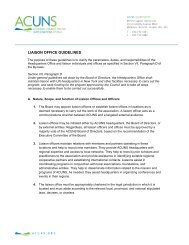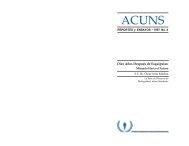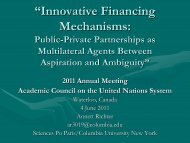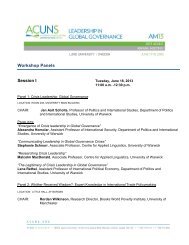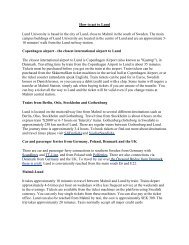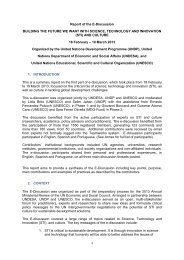THE FUTURE OF NUCLEAR ENERGY TO 2030 AND ITS ... - acuns
THE FUTURE OF NUCLEAR ENERGY TO 2030 AND ITS ... - acuns
THE FUTURE OF NUCLEAR ENERGY TO 2030 AND ITS ... - acuns
Create successful ePaper yourself
Turn your PDF publications into a flip-book with our unique Google optimized e-Paper software.
The Centre for International Governance Innovation<br />
Main Elements of the<br />
Nuclear Safety Regime<br />
• 1994 Convention on Nuclear Safety and its<br />
review meetings<br />
• 1997 Joint Convention on the Safety of Spent<br />
Fuel Management and on the Safety of Radioactive<br />
Waste and its review meetings<br />
• 1986 Convention on Early Notification of a<br />
Nuclear Accident<br />
• 1986 Convention on Assistance in the Case of<br />
a Nuclear Accident or Radiological Emergency<br />
• The International Nuclear Accident Liability<br />
Regime (various conventions and protocols)<br />
• International Atomic Energy Agency (IAEA)<br />
Safety Standards and Technical Assistance<br />
and Services, especially:<br />
◦◦<br />
Operational Safety Review Teams<br />
(OSART)<br />
◦◦<br />
Peer Review of the Effectiveness of the<br />
Operational Safety Performance Experience<br />
Review (PROSPER)<br />
◦◦<br />
Integrated Regulatory Review Service<br />
• International Nuclear Safety Group (INSAG)<br />
• International Commission on Radiological<br />
Protection<br />
• World Association of Nuclear Operators<br />
(WANO) and its peer-review process<br />
• Regional networked databases in Asia and<br />
Latin America<br />
• Other industry bodies, notably the US Institute<br />
for Nuclear Power Operations (INPO)<br />
and its peer review process<br />
• Nuclear Energy Agency (NEA)/IAEA Multinational<br />
Design Evaluation Program (MDEP)<br />
• International Nuclear Regulators Association<br />
(INRA)<br />
Increasing Adherence to<br />
and Entry into Force of the<br />
International Conventions<br />
While most existing nuclear energy states are party to<br />
the main safety conventions, there are yawning gaps in<br />
adherence by aspirant states that need to be filled before<br />
they acquire nuclear power plants. Worryingly, four<br />
SENES states ― Bahrain, Kenya, Namibia and Venezuela<br />
― are party to none of them.<br />
The nuclear liability regimes ― two competing ones<br />
originating, respectively, in the IAEA in Vienna and<br />
the Organisation for Economic Co-operation and Development<br />
(OECD) in Paris ― are in particularly poor<br />
shape despite attempts at rationalizing and integrating<br />
them. They have so few parties that some protocols<br />
have not yet entered into force years after they<br />
were negotiated and the international funds they purport<br />
to set aside are alarmingly inadequate for a major<br />
nuclear accident. These regimes should be repaired<br />
and further integrated urgently.<br />
Making the Regime More<br />
Legally Binding and Subject to<br />
Verification<br />
The international nuclear safety conventions currently<br />
set out general legally binding undertakings and general<br />
safety principles. Implementation of IAEA standards derived<br />
from such generalities are left up to each state. The<br />
question arises whether such standards should be made<br />
legally binding and compliance with them verified by international<br />
inspectors as in the case of nuclear safeguards.<br />
While superficially appealing and logical, it is not clear<br />
that making standards legally binding would help, even<br />
if it were politically possible. They are arrived at through<br />
a consultative process among states and are increasingly<br />
recognized as essential, so there is peer pressure to comply.<br />
They are also subject to periodic revision based on<br />
24 cigionline.org



